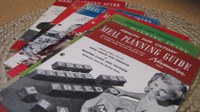Prairie Fare: Eating a Variety of Foods Can Be a Victory for Your Health
(Click an image below to view a high-resolution image that can be downloaded)
By Julie Garden-Robinson, Food and Nutrition Specialist
NDSU Extension Service
When I was young, my mom used to save the water from cooked vegetables and put it in soup. She also saved water from boiled potatoes if she was making bread the next day. The potato water contained starch to feed the yeast, so the bread turned out better with potato water, she said.
We rarely threw any food away. Leftover meat became the basis of soup or stew, and stale bread became bread pudding. When I learned to bake, my mother could scrape enough dough from the bowl to make one more cookie. I couldn’t even see any dough left in the bowl.
Sometimes I wondered what prompted this thriftiness and careful avoidance of wasting food.
The other day, I was doing some sorting and cleaning when I came upon some interesting cookbooks from the 1940s, which a friend had given me. These meal-planning guides were titled “Health for Victory” and were written during World War II. My mother was a young, single woman at the time, working in a defense plant.
If you, your mother or grandmother came of age in the 1940s, chances are these types of books were the go-to guides to stretch food during the war effort. Maybe some men read these, too, but gender roles were a little different 75 years ago.
During this time period, homemakers were advised to feed themselves and their families from the “Basic 7 Food Groups.” This was the 1940s version of “MyPlate,” which is our present-day icon illustrating our five food groups. Similar to today’s guide, the food groups were designed to be sure that people had adequate vitamins and minerals from their foods.
Can you guess what the “Basic 7 Food Groups” included? Group One included green and yellow vegetables, and Group Two included oranges, tomatoes, grapefruit and salad greens. Group Three included potatoes and all other vegetables. Group Four included milk and milk products, and Group Five included meat, poultry, fish, eggs, dry edible beans, nuts and peanut butter. Group Six included bread, flour and cereal.
We have one “food group” left in this older generation nutrition guidance. Can you guess the remaining food group? If you are thinking butter and fortified margarine, you are correct. (Yes, butter was a food group back then. Sorry, I do not see it returning as a food group any time soon.)
In the 1940s, people were encouraged to produce their own food in “victory gardens.” They also were encouraged to preserve food through canning, freezing and drying, and conserve food by avoiding waste. The 1940s guides reminded the readers to “use every crumb, every drop.”
Food was considered a “vital war material.” Food was being sent to support the troops to maintain their stamina and strength, and ration stamps for meat were to be used carefully. People were advised to stretch their meat budget by using more beans, lentils and other pulse foods.
Now let’s flash forward to today’s guidelines. Every five years, new national “Dietary Guidelines for Americans” are released. The 2015 Dietary Guidelines were released in January 2016 because nutrition often is a controversial topic. Enough said.
Today we have vast amounts of information at our fingertips. I paged through the fragile pages of old cookbooks and perused today’s guidelines on a website on my tablet computer. I was pleasantly reminded that even though times have changed and our knowledge about nutrition has grown tremendously, overall food guidance really is quite similar.
Our ancestors were taught to eat a variety of foods to get the nutrients their body needed. We still need variety. However, we may need to remember moderation more than our food-rationing ancestors, who had a much lower incidence of overweight than today’s generation.
Despite all of our technical advancements and wide availability of all sorts of foods, we can learn some vital lessons from a previous generation. Why not try our best to waste less food, grow more of our own food or buy food grown close to home, eat a variety of foods and prepare it in our own kitchens?
The following are the key recommendations from the 2015 to 2020 Dietary Guidelines. A healthy eating pattern includes:
- A variety of vegetables from all of the subgroups – dark green, red and orange, legumes (beans and peas), starchy and other
- Fruits, especially whole fruits
- Grains, at least half of which are whole grains
- Fat-free or low-fat dairy, including milk, yogurt, cheese, and/or fortified soy beverages
- A variety of protein foods, including seafood, lean meats and poultry, eggs, legumes (beans and peas), and nuts, seeds and soy products
- Oils
In the collection of cookbooks, I had more than 800 recipes to choose from, but this one captured my nostalgia and serves as a hearty comfort food for a cold, wintry evening. It’s from the November 1943 edition of “Health for Victory,” monthly prepared by the Home Economics Institute in Mansfield, Ohio, in the interest of the National Wartime Nutrition Program. I added the nutrition analysis, which wasn’t available in early cookbooks.
Queen of Rice Pudding
1 1/2 quarts milk (2 percent)
1 c. rice (dry)
1 c. sugar
1 tsp. salt
1 c. raisins
Grated rind of 1 lemon
2 large eggs, well beaten
1/8 tsp. nutmeg
Heat milk to scalding on high heat. Add rice, sugar and salt, stir well and turn down burner to simmer. Simmer for 45 minutes, then add raisins and lemon rind. Continue to simmer for 15 minutes longer. Pour some of the rice pudding over the beaten eggs, stirring well, then pour the egg mixture back into the pudding pan and cook two minutes longer. Add nutmeg and cool.
Makes eight servings. Each serving has 350 calories, 5 g (grams) fat, 9 g protein, 67 g carbohydrate, 1 g fiber and 400 milligrams sodium.
(Julie Garden-Robinson, Ph.D., R.D., L.R.D., is a North Dakota State University Extension Service food and nutrition specialist and professor in the Department of Health, Nutrition and Exercise Sciences.)
NDSU Agriculture Communication - Jan. 21, 2016
| Source: | Julie Garden-Robinson, (701) 231-7187, julie.garden-robinson@ndsu.edu |
|---|---|
| Editor: | Ellen Crawford, (701) 231-5391, ellen.crawford@ndsu.edu |



